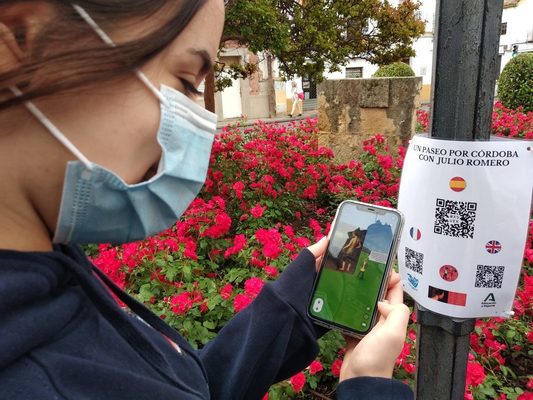http://sdw-blog.eun.org/2021/04/26/a-walk-through-cordoba-with-julio-romero-de-torres/
The students of IES Blas Infante from Córdoba, Spain, carried out a STEM project with the aim of discovering more about several places in their city through pictures of the most important artist of the city, Julio Romero de Torres. They created a tour around the city locating different places that appear in pictures of Julio Romero. To make the walk more powerful, on each place there is a QR code that allows the visitor to explore a virtual scene created with CoSpaces Edu in order to know the picture where this place is represented and the most important information about this painting.
The project has been developed from February to the end of April in order to achieve the following objectives:
- To learn more about our city Cordoba and the life and work of the Cordovan painter, Julio Romero de Torres
- Create virtual scenes to show the painter’s work and relevant information about it.
- Use a block based programming language to define the interaction in the virtual scene.
- Learn to use collaborative work tools to create multimedia contents that facilitate remote working.
- Promoting professional vocations within and outside the STEM field among the participating students.

The picture is the author’s own – (Attribution CC-BY)
In order to develop all the work included in this project, the following phases have been defined
STAGE 1
Looking for information. The students worked on a common text document to search for information about the works and places in the city that were included in the project. The teacher provided the pictures and places that could be included, ensuring that each picture showed an important place of the city of Cordoba. The information collected was worked on in Spanish, English and French. The students worked in groups of 2 or 3 people, each group working on a picture and the corresponding place in the city.
STAGE 2
Creating the virtual scene. After completing the required information, each group of students have created a virtual scene using CoSpaces Edu in order to show the picture they worked on with the relevant information. Three scenes have been created for each picture, one in each language. The scenes have a common structure to maintain a certain homogeneity among the groups, although each one has different decorative elements that make its exhibition more pleasant.
In each scene, the students have coded the interaction with a character that shows the information of the picture. For this work they have used a block based programming language included in the educational tool (CoBlocks), allowing them to improve the skills associated with computational thinking.
STAGE 3
Another product creation. With all of the above, and the materials necessary to carry out the walk and visit, the virtual scenes have been created. But in order to give the project more entity and encourage the development of personal skills that help to promote professional vocations among our students, we have given the opportunity to work on the project by doing what each person is better skilled at. For this part, the following products were proposed:
– A map with information about the route and each place of interest within the walking tour.
– A virtual tour with 360º panoramic images to learn about the places within the tour in advance.
– A video presentation of the project.
– An article to be published in the local newspaper (Diario Córdoba).
– An informative brochure so that the people who take the walk have all the necessary information available.
– A template to post the QR codes in each place of the walk.
All these products are totally different tasks that require skills from different fields and that greatly enrich the educational project. The objective of giving this opportunity is that each student will be able to know what he/she likes the most and what he/she can contribute to this common goal.
STAGE 4
Putting the tour into practice. With all the material prepared and printed out appropriately, the students followed the defined route to see the work they had done. This walk ended in the official museum of Julio Romero de Torres, where each group was able to enter to see the painting they had worked on and the other works included in the walk. In conjunction with the museum organisers, a small activity was defined to be carried out inside the museum to round off a complete STEM learning experience integrated with the artistic and cultural heritage of our city.
To make the project more visible, a group of students are continuing to work on a voluntary basis on the translation of the information leaflets and the writing of the press article into English for publication on other educational platforms. They are also developing an interactive resource using Genial.ly (coming soon) so that anyone who does not live in the city, can enjoy all the material produced to learn about this walk through Cordoba from the hand of Julio Romero de Torres.
Likewise, the article written by the students has been published in the local press and the teacher involved will participate in a local educational lecture to share this experience with other professionals in the field of education. In addition, on 18 May, International Museum Day, we will be at Julio Romero de Torres Museum to explain how this project has been developed to learn about our heritage through STEM practices.
At the end of the project, the students were asked what they liked best. Their answers were unanimous and they all highlighted that what they liked the most was Julio Romero de Torres Museum. In addition, they said that having done the project before visiting the museum raised their expectations and allowed them to look at details more closely. With this conclusion, I recommend all readers to do STEM activities before visiting a museum.